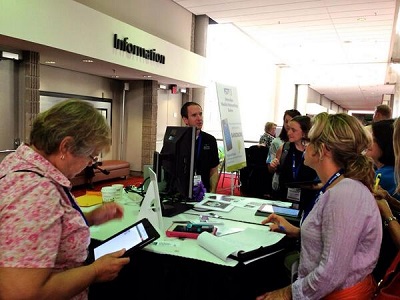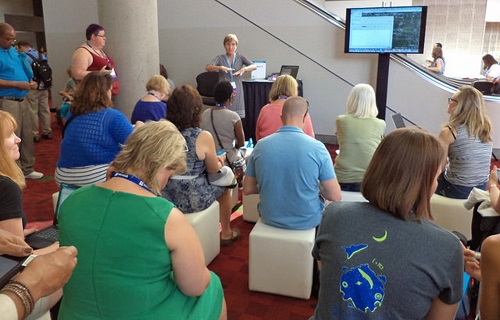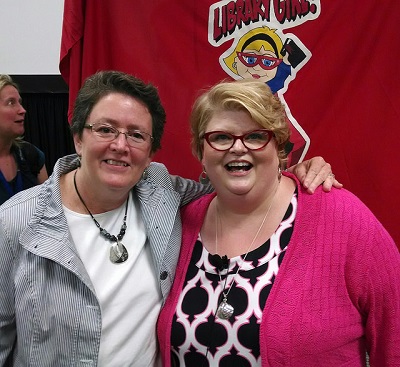-

Librarians playing at learning stations at the Digital Age Library Playground event at ISTE on June 29. Photo courtesy of Andy Plemmons.
Each year, teacher librarians who want to continue their professional learning throughout the summer, by attending a big, national conference, face a tough choice: ALA or ISTE? For the past several years, the dates of these two mega conferences have been so close together that many teacher librarians have had to embark on cross country, multi-city adventures in order to participate in both. This year, however, dual conferencing was not an option. The dates for ISTE (June 28 – July 1) and ALA (June 26 – July 1) overlapped, forcing those of us with competing loyalties to make a choice. For me the choice was ISTE. But even as I filled out the registration paperwork, I could not help by wonder if I’d be the only one of my colleagues to choose the ed tech conference over the one specifically for librarians.
As it turned out, I had nothing to worry about. Not only were there thousands of teacher librarians from around the world at ISTE, but I simply could not have been prouder of the network of school librarians whose participation at the conference shined as an example of how technology tools are only as effective as the instruction they accompany. Nowhere was this more evident than at the Digital Age Library Playground, an “unconference” event organized by Tiffany Whitehead and Donna MacDonald, that took place June 29.
At conferences as large as ISTE or ALA, it can be difficult to model participatory pedagogical practices. Let’s face it: engaging adult learners in exploratory, collaborative activities that also allow for questions and reflection can be a tall order in any given faculty meeting, never mind in a room full of several hundred people. Which is why, when it comes to the big show, lecture-style instruction often rules the day. The Digital Age Library Playground, however, broke this rule and those who were able to attend were better for it.
Let me set the stage: In the gallery area adjacent to and overlooking several floors of concurrent sessions, eight interactive learning stations were set up. Each station setup had a different flavor ranging from tables that participants could gather around to mini-ampitheaters made up of movable white cubes that could be used for seating or a mobile workspace, depending on the need.

At one of the learning stations, librarians gather to listen and then try out what they learned. Photo courtesy of Donna McDonald.
Reardless of the arrangement, however, there was one thing that each station had in common: a mission to provide participants with the opportunity to:
- Network and connect with other school library professionals.
- Explore new and innovative instructional strategies that incorporate the latest digital tools.
- Vote with their feet. That is to say, spend as much or as little time at a session as they wanted.
- Get their hands dirty by digging in, testing how things work, and learning by doing.
And that is exactly what went on. For three hours, teacher librarians excitedly milled from station to station, absorbing knowledge, connecting with colleagues, and exploring new strategies rather than just hearing about them. At any given time, hundreds of people could be found in the playground, not only taking in the presenters’ shared knowledge, but more significantly, building new knowledge by using the resources being discussed. Rather than just espousing the benefits of experiential learning, the Digital Age Library Playground modeled this instructional practice in an incredibly effective way.
What’s more, this modeling of participatory learning strikes at the heart of how school librarians are evolving as instructional and pedagogical leaders within their schools. The playground was a buzzing hive of activity that, not unlike any good school library, must have looked, from the outside, like well organized chaos. It only took one step inside, however, for the magic happening within all that activity to come into clear focus.
Here’s what was happening at some of the playgrounds.
- Elissa Malespina coached her colleagues in the use of the apps Layar, ColarAR, and Chromeville as resources for harnessing the power of “Augmented Reality in Your Library” as both an instructional and library marketing tool.
- Nikki Robertson shared the story of how making her instruction “rewindable” by flipping (or reinventing) her library changed the learning lives of her students and also engaged her colleagues in activities that put the power of that technology in their hands during “Flipping Your Library: Making Learning ‘Rewindable’ for Teachers and Students Using Google Hangouts On Air.”
- Tiffany Whitehead and participants explored the features of cloud-based photo editing software, like Pic Monkey, as part of a digital toolchest for engaging kids in maker-activities, wherein the library becomes a space for not just absorbing knowledge, but for creating it, too, in “Photo Editing with PicMonkey.”
- Matthew Winner and Sherry Gick helped their colleagues view the library’s “collection” as more than just an assemblage of print and digital materials, but as the communities they serve and grow through the story of “GeniusCon“—an event in which students from around the world shared their big ideas to affect social change.

2011 Library Journal Mover and Shaker and “Library Girl ” blogger Jennifer LaGarde. Photo courtesy of Donna McDonald.
Each station was so different, and yet united by the important goal of pushing our profession forward and helping evolveschool libraries from passive places, defined by the stuff they house, to living, changeable spaces synonymous with the learning that takes place there.
Through this event, and others like it, ISTE’s school librarians experienced a true “playground:” a place to connect, create, and try something new in a safe environment.The Digital Age Library Playground helped move the theory of active, participatory library spaces into reality by really showing ISTE attendees what such a space looks like in action.
During the second hour, I stepped outside all of the action to refill my water bottle and take a breath. I overheard some teacher librarians from Switzerland chatting. “This,” one of them said casting a wide wave across the scene, “this is what I want my library to look like.” In truth, don’t know if this is what the organizers of the Digital Age Library Playground had in mind when they conceived the idea, but I can’t think of a better outcome.
Jennifer LaGarde is the Librarian on Loan for the North Carolina Department of Public Instruction. She is a 2011 Library Journal Mover & Shaker and a 2011 winner of the ALA, NYT Carnegie Corporation’s “I Love My Librarian” Award. Jennifer is the co-host of the popular EdGeeks podcast and the author of the Adventures of Library Girl blog. On Twitter at @jenniferlagarde; also www.librarygirl.net.


